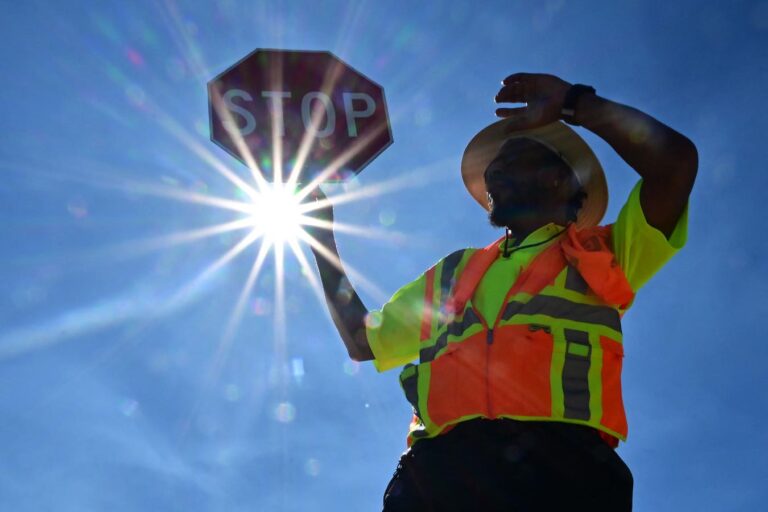Heatstroke can be a serious health risk for the approximately 32 million outdoor workers in the United States. … [+]
If you haven’t experienced it firsthand yet, we’re warning you: it’s scorching hot in most parts of the country. According to the National Oceanic and Atmospheric Administration, there’s a 61% chance that 2024 will be the hottest year on record, likely one of the top five hottest years on record. With summer temperatures expected to continue to rise, and the potential for extreme heat, many businesses are rethinking their strategies for keeping employees safe and productive.
As predicted earlier this year, a heat wave blanketed much of the country, bringing dangerously high temperatures to many Americans throughout June. Extreme heat and humidity are among the leading causes of weather-related deaths in the United States, resulting in hundreds of deaths each year. Last year, 2,300 people died as a result of excessive heat, and nearly 120,000 emergency room visits were reported by people experiencing heat stress.
The effects of heat on workers’ health
Heatstroke can be a serious health risk for the approximately 32 million outdoor workers in the United States, especially those who work in industries like construction, landscaping, and agriculture. The U.S. Department of Health and Human Services reports that one study found agricultural workers are 35 times more likely to die from heatstroke than the general population. But outdoor workers aren’t the only ones at risk of heatstroke. People who work in warehouses, bakeries, and similar environments are also exposed to heat-related risks.
Some industries are subject to regulatory requirements for heat stress management. For example, the Occupational Safety and Health Administration (OSHA) provides guidelines to help prevent heatstroke and death in outdoor workers. However, industries that are not regulated do not have standard extreme heat safety protocols. This makes it even more important to understand and recognize the threat of extreme heat before it becomes a serious health risk.
Extreme heat reduces productivity
Extreme heat also impacts productivity. In 2021, more than 2.5 billion hours of outdoor work in the United States were lost due to heat exposure, potentially costing the U.S. economy up to $100 billion. Individual states and cities are also affected. In Texas, the study found that the economy is particularly vulnerable to hot summers, with every 1 degree increase in average summer temperatures reducing the state’s annual GDP growth rate by 0.4 percentage points.
So what can businesses and workers do when record-breaking temperatures occur and meteorologists predict it? Use the power of weather data to plan and prepare.
Using weather data to manage the risk of heatstroke
Companies can leverage weather data technology to improve risk information and develop and implement heat risk management strategies, including training programs and safety protocols.
Access to weather analytics is one of the most underutilized yet readily available resources corporate safety teams can use to prepare for extreme heat events.
While extreme weather events such as tornadoes and severe thunderstorms are often associated with real-time radar and storm tracking information, those seeking insight into broader, longer-term weather phenomena such as heatwaves can also benefit from the use of longer-term forecasts and weather analytics. Integrating weather insights into enterprise safety management allows leaders to make more informed decisions based on real-time and forecast information.
Understanding Wet Bulb Globe Temperature
Guidelines from the Occupational Safety and Health Administration recommend the use of a Wet Bulb Globe Temperature (WBGT) monitor to measure heat in the work environment. For those who work outdoors, knowing the WBGT is an important assessment of heat stress and is necessary to keep employees safe in high temperatures. Most people are familiar with the heat index and the “feels like” temperature that is obtained by calculating the humidity and temperature in the shade to determine the effect that temperature has on someone who is outdoors. However, a more accurate way to measure heat stress on the body is the Wet Bulb Globe Temperature (WBGT). The calculation of WBGT incorporates multiple factors, including the temperature of direct sunlight, humidity, the angle of the sun, wind speed, and cloud cover. Each factor plays a key role in determining heat stress on the human body. For example, extreme heat combined with high humidity and a light breeze can be more dangerous than expected because the body’s natural cooling mechanisms do not work efficiently.
Although temperatures may fluctuate, the midsummer season shows no signs of abating the recent trend of extreme heat across the U.S. With the heatwaves across the country showing no signs of ending anytime soon, heat remains a pressing concern for employees both indoors and outdoors. There are steps you can take now, including how to recognize and prevent symptoms of heatstroke, and how to use WBGT and other data to make informed decisions about how to keep your employees safe and healthy.

